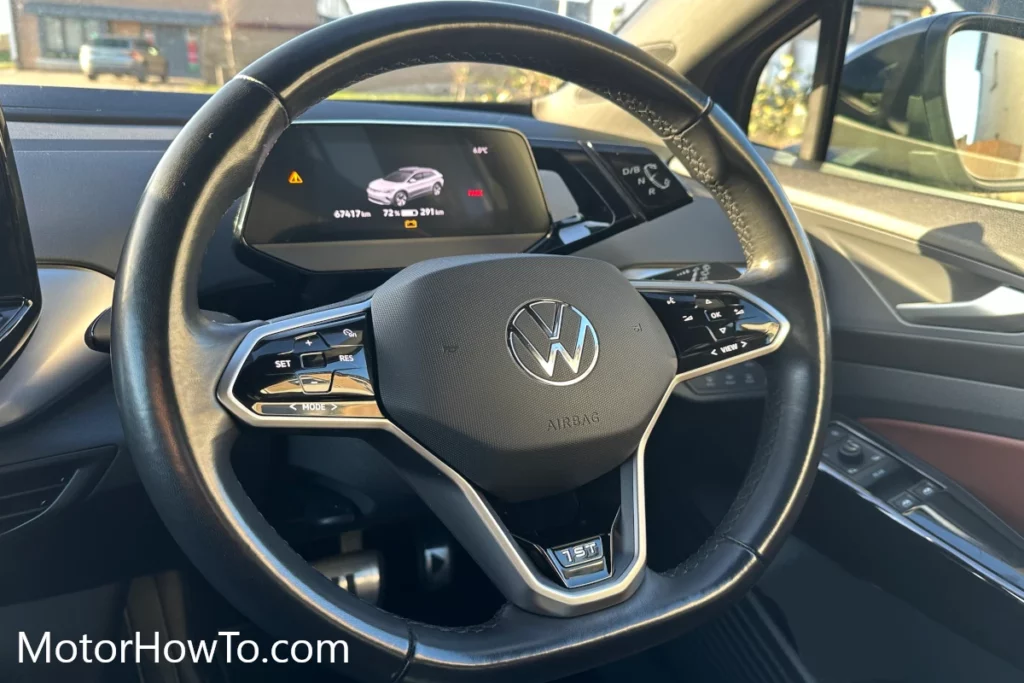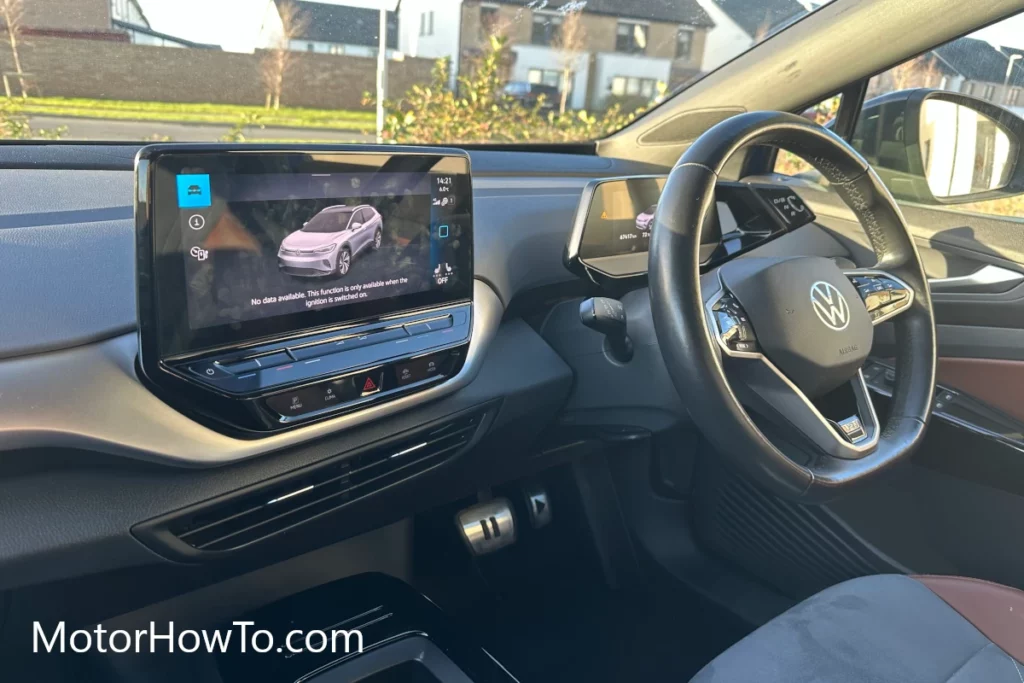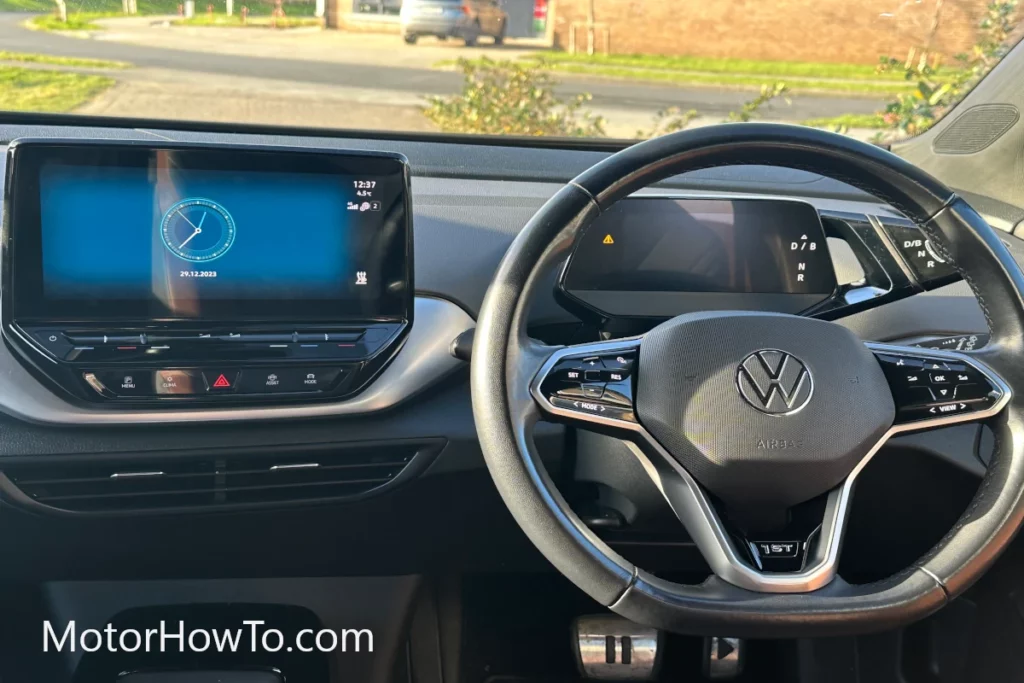Many electric vehicle (EV) enthusiasts and potential buyers have asked if EVs have different steering wheel sizes than traditional gasoline-powered vehicles.
Understanding the size of the steering wheel in an EV can be important for a comfortable driving experience, and it’s important to know if there are differences in size between traditional vehicles and EVs.
EV steering wheels can have different sizes compared to traditional gasoline-powered vehicles. EV steering wheels are usually smaller than their traditional combustion engine counterparts.

In this article, we will explore the different factors that can impact the size of a steering wheel in an EV, such as the make and model of the vehicle, the type of power steering system used, and other design elements.
Additionally, we will examine the different opinions and experiences of EV drivers about the size of their steering wheels.
Whether you are a current EV owner or considering purchasing one, this article will provide valuable insights into EV steering wheel sizes.
Related:
- Do Electric Cars Have Handbrakes? (Explained For Beginners)
- Why Electric Cars Have Fan Noise Even When Turned Off? (Explained)
- What If The EV Has The A/C On? (How Long Will It Last)
Why do EV Steering Wheels Have Different Sizes?

The size of a steering wheel in an electric vehicle can be impacted by several factors, including the design and make of the vehicle, the type of power steering system used, and ergonomic considerations.
An EV’s design can influence the steering wheel’s size, as some manufacturers may opt for a smaller or larger steering wheel to suit the vehicle’s aesthetic. For example, a sporty EV may have a smaller steering wheel for a more dynamic look, while a family-oriented one may have a larger one for increased comfort.
Another factor that can impact the size of an EV steering wheel is the type of power steering system used. Electric power steering systems are becoming increasingly common in EVs and can impact the steering wheel size. These systems typically require a smaller steering wheel to make room for the necessary components.
An EV steering wheel size can vary greatly between different models and manufacturers. Some EV owners have reported feeling comfortable with the size of their steering wheel, while others have preferred a larger or smaller size.
Furthermore, ergonomic considerations such as driver comfort and accessibility also play a role in determining the size of an EV steering wheel.
It’s important for potential EV buyers to consider their preferences and driving habits when choosing a vehicle and to test drive multiple models to determine which one is the most comfortable and suitable for their needs.
Characteristics Of Different Power Steering Systems Used In EVs
The first type of power steering system used in EVs is the hydraulic power steering system. This system uses hydraulic pressure generated by a pump powered by the vehicle’s engine.
The hydraulic pressure is then used to assist the driver in turning the wheels. This power steering system is commonly found in conventional gasoline-powered vehicles and has proven reliable and effective.
However, it is not ideal for EV use as it requires a constant power source and can result in significant energy loss.
Another power steering system used in EVs is the electric power steering (EPS) system. This system uses an electric motor and a rack-and-pinion system to assist the driver in turning the wheels.
The electric motor is powered by the vehicle’s battery and operates independently of the engine, making it much more efficient and ideal for EV use.
A third type of power steering system used in EVs is the steer-by-wire system, also known as drive-by-wire.
This system operates entirely electronically and does not use a mechanical connection between the steering wheel and the wheels. Also. this system is typically lighter and more compact than hydraulic systems and does not require as much maintenance.
Instead, electronic signals transmit the driver’s inputs to the wheels. This system provides greater flexibility and improved responsiveness compared to traditional hydraulic and EPS systems.
However, it is also more complex and requires advanced software and hardware to function effectively.
Pros And Cons Of Different Size Steering Wheels?

One advantage of a smaller steering wheel in an electric vehicle (EV) is that it can provide a more direct and responsive driving experience, which can be beneficial for sporty driving or for navigating tight turns and maneuvering through city streets.
Also, a smaller steering wheel can make it easier to reach and operate other controls and features within the vehicle, such as the infotainment system or navigation controls. However, there are also some disadvantages to a smaller steering wheel.
A smaller steering wheel can be less comfortable for some drivers, particularly those with larger hands or those used to a larger steering wheel in a traditional gasoline-powered vehicle.
A larger steering wheel can provide a relaxed and comfortable driving experience, benefiting long drives or drivers with larger hands.
A smaller steering wheel can also provide less leverage and make it harder to control the vehicle, particularly during emergencies or sudden movements. On the other hand, a larger steering wheel can offer several advantages in terms of comfort and control.
A larger steering wheel can provide increased leverage and control, making maneuvering the vehicle easier, particularly in emergencies or sudden movements. However, there are also some disadvantages to a larger steering wheel.
A larger steering wheel can make it more difficult to reach and operate other controls and features within the vehicle, such as the infotainment system or navigation controls.
Also, a larger steering wheel can make the driving experience feel less direct and responsive, which can be less appealing for sporty driving or for navigating tight turns and maneuvering through city streets.
Do EV Owners Prefer Normal or Smaller Steering Wheels?
The preference for a normal or smaller steering wheel in electric vehicles (EVs) can vary greatly among EV owners. Some drivers prefer a normal-sized steering wheel for increased comfort and a more traditional driving experience, while others prefer a smaller steering wheel for a sportier feel.
It’s important to note that the size of a steering wheel can also impact the level of control and feedback a driver feels when driving an EV.
A smaller steering wheel can provide a more direct and responsive driving experience, while a larger one can offer a more relaxed and comfortable driving experience. Ultimately, the preference for a normal or smaller steering wheel in an EV will depend on individual driving habits and personal preferences.
Some drivers may feel comfortable with a smaller steering wheel, while others may prefer a larger one for increased comfort. It’s recommended that potential EV buyers test drive multiple models to determine which steering wheel size is the most comfortable and suitable for their needs.
Is It Recommended To Change the Steering Wheels Size?
Whether or not to change the size of a steering wheel in an electric vehicle (EV) will depend on several factors, including the preferences and driving habits of the owner, as well as the design and features of the vehicle.
In general, it’s recommended to stick with the size of the steering wheel originally installed in the vehicle, as altering the steering wheel’s size can impact the vehicle’s performance, safety, and stability.
It’s important to remember that changing the steering wheel size can affect the vehicle’s alignment and balance and can also impact the performance of the power steering system.
Additionally, altering the steering wheel size can void the vehicle’s warranty, as it constitutes a modification that the manufacturer did not approve. If an EV owner is considering changing the size of their steering wheel, it’s recommended that they consult with a professional mechanic or a specialist in EV modifications.
A professional can assess the vehicle and determine if it’s safe and feasible to change the size of the steering wheel and can also make any necessary adjustments to ensure that the vehicle remains safe and stable. It’s also important to consider the cost of the modification and any potential impact on the vehicle’s resale value.
Conclusion
The size of a steering wheel in an electric vehicle (EV) can vary based on several factors, such as the design and make of the vehicle, the type of power steering system used, and ergonomic considerations.
Smaller and larger steering wheels have advantages and disadvantages regarding comfort, control, and accessibility. The preference for a normal or smaller steering wheel can depend on individual driving habits and personal preferences.
Potential EV buyers should test drive multiple models and consider their driving habits and preferences to determine which steering wheel size is the most comfortable and suitable for their needs.
While it may be tempting to change the steering wheel size for personal preference, it is generally recommended to stick with the original size of the steering wheel installed in the vehicle.
Altering the steering wheel’s size can impact the vehicle’s performance, safety, and stability and should only be done by a professional and with caution.
Sources
Why Car Steering Wheel Sizes Differ?
What Difference Does The Wheel Size Make?
Tesla Offers Round Steering Wheel For Yoke-Hating EV Owners
Should you modify your steering wheel?
Pros / con of after market steering wheel?



